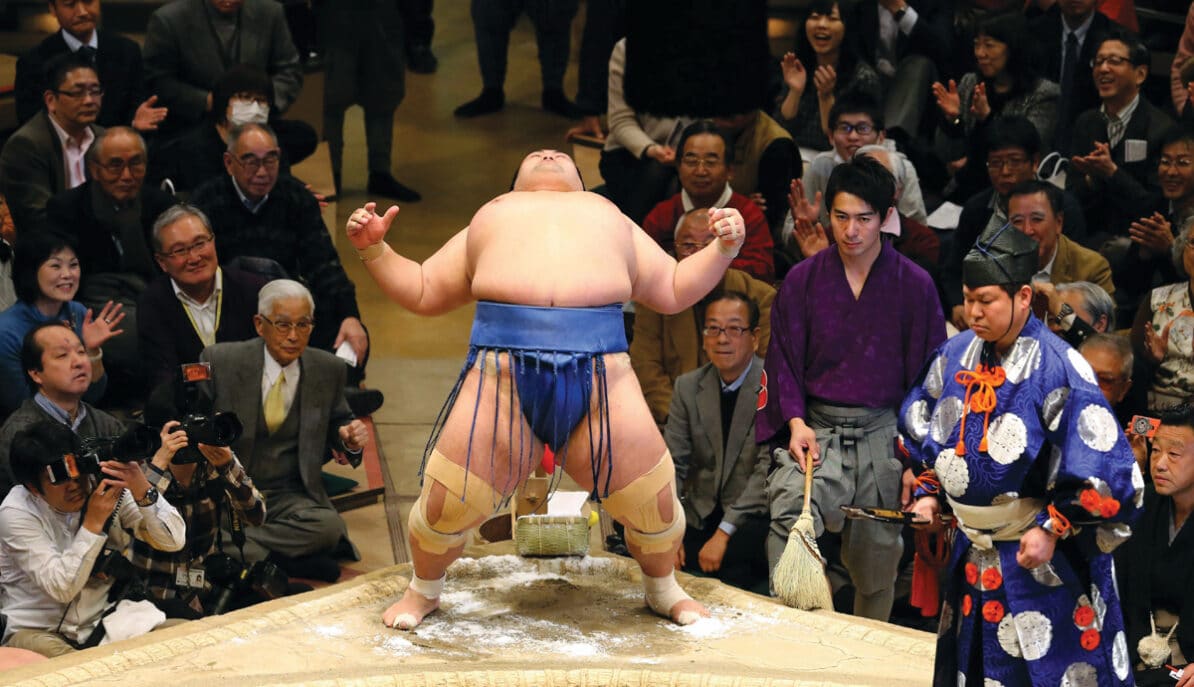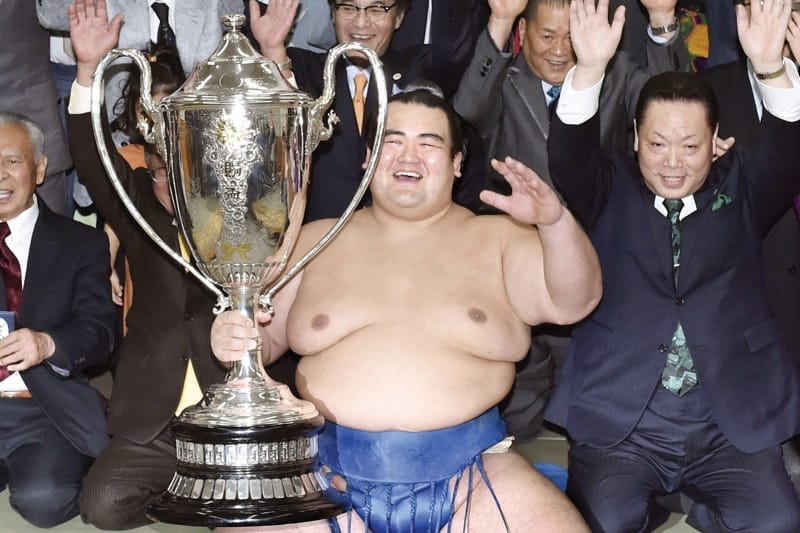Moment that mattered: Kotoshogiku becomes Japan’s first sumo champion in a decade
In 2016, after Japan celebrated its first homegrown winner of sumo’s prestigious Emperor’s Cup in ten years, we spoke to sumo commentator and former fighter John Gunning about what it meant – both for the country and for the sport

Kotoshogiku performs his trademark warm-up before a bout against Tochiozan Yuchiro on day 14 of the New Year Grand Sumo tournament. Photo: Norimitsu Masuda / AP / PA Images
24th January 2016 (Taken from: #22)
“Kotoshogiku winning the New Year Grand Sumo tournament and taking the Emperor’s Cup was a historic moment: it made him the first native-born Japanese sumo champion in ten years. The sport has been dominated by Mongolian fighters for a very long time; even an Estonian was champion in 2012, and nobody expected it would be Kotoshogiku who would end the Japanese wait for a homegrown champion. It’s as surprising as Leicester City winning the Premier League.
“Kotoshogiku is relatively old for a sumo wrestler – he was 31 when he won – and, while he’s good, it takes something exceptional to be a champion. There were many, including me, who thought he didn’t have it in him. A lot of people have put his success this time down to the fact that he got married. It seemed to light a fire under him: he changed his training regime and brought in a sports psychologist. Maybe he was trying to impress his new wife?
“In sumo, at the top level, it is all in the head. It is a strange sport in that there’s no second half, no margin for error – if you don’t win on the initial charge there’s no way to recover. You need to take split second decisions, and people tense up under the pressure, especially when there is 28-plus stone of muscle charging at them from the other side of the ring.
Sumo is a unique world. For wrestlers like Kotoshogiku it’s like a cross between being in the military and being a cloistered monk”
“The Japanese guys are under even more pressure because of the wait for a homegrown champion, and when they have been in a position to win tournaments recently they seem to have collapsed under the weight of expectation. This year, Kotoshogiku didn’t.
“I’m a sumo commentator for NHK, Japan’s national broadcaster and a former fighter myself, so I’m present at every tournament. I came to Japan from Ireland 16 years ago: it was in the days before broadband, so if you wanted to entertain yourself you watched Japanese TV, and sumo was one of the few things I could understand. It is a simple sport – the rules are basically that you have to get your opponent down or out of the ring. Like everyone, I had a clichéd image of fat guys in nappies pushing each other about, but when I started watching properly I realised they were insanely strong athletes.
“You could see the muscles bulging in their legs, and the slaps they gave each other looked like they’d knock you out cold. It’s a really violent sport and I was attracted to it immediately. I trained with some pros and fought in the World Championships for Ireland before retiring and getting into commentating.
“Sumo is a unique world. For wrestlers like Kotoshogiku it’s like a cross between being in the military and being a cloistered monk. There can be a real Lord of the Flies-type atmosphere. You’ve got 20 guys aged between their teens and their thirties in a ‘stable’ – the older ones have been there for 15 years. They all sleep on futons in one large room. So there’s no personal space and girlfriends and wives are banned for the apprentices.
He’ll always be the guy that broke the ten-year hoodoo”
“There’s already a huge amount of testosterone before you factor in that their job is to fight each other for hours every day. Stress builds up and if the stable master doesn’t carefully control it, trouble can brew between fighters. Stables are like families, but they can cover everything from the Von Trapps to the Manson Family.
“And wrestlers like Kotoshogiku are putting their bodies on the line playing this sport. The big issue that hasn’t hit sumo yet – but has hit other sports like rugby and American football – is concussion. There was a study last year on the brains of 94 ex-pro NFL players and 90 had CTE [chronic traumatic encephalopathy], a degenerative disease of the brain caused by regular impact. That’s American football, where the players wear helmets. Meanwhile in sumo they smash together with their bare heads, and you hear that coconut sound every day at training and in tournaments. I think that’s a ticking time bomb. It hasn’t reached the public consciousness yet, but when it does, something fundamental is going to have to change.

Kotoshogiku poses with the Emperor’s Cup at Tokyo’s Ryogoku Kokugikan, 24th January 2016. Photo: Kyodo / AP / PA Images
“For now, though, the sport is on a high. Ten years ago the viewing numbers were going down, the ticket sales weren’t great and there were fewer young wrestlers joining the sport. The sumo association realised it wasn’t just competing with other sports; it was now competing with computer games, the internet and all the other things that are available to kids these days. So they started interacting with the public a lot more. They removed the mystery and that’s helped bring the sport back in people’s minds.
“Kotoshogiku’s victory will definitely help boost sumo’s popularity further. Weirdly enough, his warm-up has become almost as famous as his victory. Before his fights, he started doing a big stretch routine – a ‘fight spirit’ – pulling his arms back and looking up to the sky. People started calling him ‘Koto-Bauer’, after the German ice skater Ina Bauer. A lot of sumo’s popularity depends on the wrestlers themselves and this gave him a little more personality.
“For two weeks after the win, Kotoshogiku was very big news. He was floated down a river on a barge in a parade in his home prefecture. If he had won the next tournament he would have earned the title of yokozuna [grand champion] – there hasn’t been a Japanese yokozuna since 2003 – but he didn’t do well at all.
“If I’m honest, I don’t think Kotoshogiku will win another tournament. Once you get over 30 it gets very, very difficult. He’ll probably continue for a while longer, but I’d expect to see him retire fairly soon. Financially he did very well by winning the Emperor’s Cup – not just the victory bonus, but the extra sponsorships and so on. He’ll always be the guy that broke the ten-year hoodoo. Even if he spent until Christmas drinking nobody would care – he’s earned it.”
Slow Journalism in your inbox, plus infographics, offers and more: sign up for the free DG newsletter. Sign me up
Thanks for signing up.








